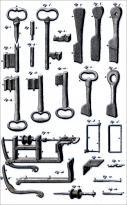L' histoire de Metz et de la Lorraine, histoire de la moselle - cartes postales anciennes de Metz - cartes postales anciennes de Moselle - histoire Moselle

Maison N°34, Rue Taison
A few clarifications about the profession in the 19th century.
The apprenticeship used to last five years on average, and so did the companionship; ten years in total before gaining the right to make ones masterpiece and ask for the diploma.
On the other hand, the sons of the masters, and even their sons-in-law, were dispensed with any apprenticeship. They only have to have some experience, the statutes said. It would be wrong to think that the locksmiths made only locks. The best locks, and the most renowned of the Forez, were made in Picardy, principally in the city of Eu, of which almost all inhabitants dedicated themselves to this activity. The ironmongers would bulk-buy them and retail them to cabinetmakers, locksmiths, etc. The latter would only make ordered locks themselves, or locks with ten levels of safety, for strong-boxes or cases of traders or jailers. It was generally this kind of locks that companions
asking for their diploma were charged to make as their masterpiece.
The real works of the locksmith were the pieces required for frameworks: anchors, clamps, bolts, etc.; cleaning utensils, latches, hinges, pivots and other pieces of the same kind; but most of all gates and balustrades, which the taste of that era wanted to be as rich and ornamented as possible. Another work that would be quite lucrative for the craftsmen of this profession later was barely known in France, at the end of the 19th century: the espagnolette. At that time, shutters, windows and wind-braces were locked with bolts or even locks. The espagnolette, thanks to its longitudinal iron bar, has the advantage of locking in a more equal, complete way. It was brought from Spain, following the war that set Phillipe 5, Louis 14s son, on the throne in this country. Its use would soon become common.


